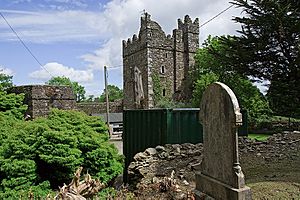Rathmacknee Castle facts for kids
Quick facts for kids Rathmacknee Castle |
|
|---|---|
| Native name Irish: Caisleán Ráth Mhac nAodha |
|
| Rathmacnee Castle | |
 |
|
| Type | tower house |
| Location | Rathmacknee Great, Rosslare Strand, County Wexford, Ireland |
| Area | Carnsore Point region |
| Built | late 15th century |
| Owner | State |
| Official name: Rathmacknee Castle | |
| Reference no. | 434 |
| Lua error in Module:Location_map at line 420: attempt to index field 'wikibase' (a nil value). | |
Rathmacknee Castle is an old tower house and a special National Monument in County Wexford, Ireland. It's a cool example of a strong castle from a long time ago!
Where is Rathmacknee Castle?
Rathmacknee Castle is found in the southeast part of County Wexford, Ireland. It's about 6.3 kilometers (about 4 miles) west of Rosslare.
The Story of Rathmacknee Castle
People think Rathmacknee Castle was built by John Rosseter. He was an important person called a "seneschal" (say: SEN-uh-shal) in Wexford around the year 1415. A seneschal was like a manager or governor of a special area. Other stories say his grandson, Thomas Rossiter, built it later, around 1493.
The Rossiter family stayed Catholic even after a big religious change called the Reformation. But they were still loyal to the king or queen. This meant they kept their land and castle.
Later, during a time of war in Ireland, Col. Thomas Rosseter fought against Oliver Cromwell's army. This happened at Wexford in the 1600s. Because of this, the castle and lands were taken away from the Rossiters in 1654.
Even after being taken, people lived in the castle until about the 1760s. In the 1800s, the castle was fixed up by its owner, Hamilton Knox Grogan Morgan.
What Rathmacknee Castle Looks Like
Rathmacknee is a tower house or caiseal. It stands in the southeast corner of a five-sided bawn. A bawn is a strong wall that protects the castle. There's also a small tower called a bartizan on the bawn wall.
The main tower is five storeys high. The top of the tower has special crenellations (say: kren-uh-LAY-shuns). These are the tooth-like shapes on the parapet (the low wall at the top).
The entrance to the tower has a slot for a drawbar, which was used to lock the door. There's also a murder-hole above the entrance. This was a small opening where defenders could drop things on attackers.
Inside, the upper rooms have fireplaces to keep warm. They also have vaulted ceilings, which are curved like an arch. You can also find garderobes, which were old-fashioned toilets.
The tower was built near a ford, which is a shallow place to cross a river. There was also a holy well nearby, dedicated to St Martin. A church and graveyard were to the south, and protective earthworks (mounds of earth) were to the north.

